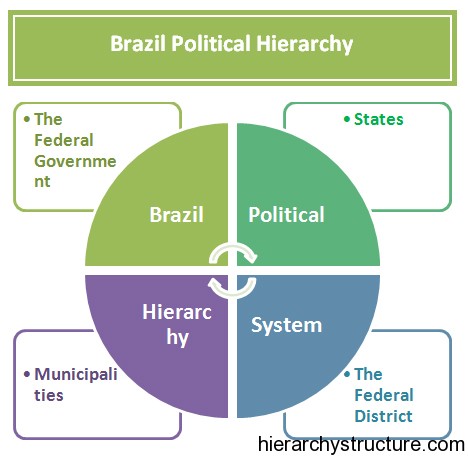When we consider Brazil Political Hierarchy, it is known to be a federal republic including 26 states and a federal district. The federal government is rich in powers which were allotted by the constitution in 1988. It is further classified into executive, legislative and judicial classes which operate with each other with harmony and due respect. The president of Brazil works on terms of four years. The hierarchy of Brazil revolves around the federal presidential representative democratic republic.
The central government in the Brazil Political Hierarchy is supervised by the federal government using executive, legislative and judicial branches. The president along with the cabinet, the National congress and the judiciary is responsible for executing the executive, legislative and the judicial powers respectively. The states of Brazil are independent entities of the Brazil Political Hierarchy and work on their own constitution and government which ultimately forms the part of the federation unit.

The Brazil Political Hierarchy is comprised of various levels like the Federal government, States, Municipalities and the Federal district. These entities of the Brazil political system are described as follows:
- The Federal Government: Brazil is a democratic federal presidential republic and it has further three categories such as executive, legislative and judicial which are not correlated to each other. The duties of the president involve the supervision of the executive power and serves as the head of the state as well as the government. The National congress, a unit of federal senate is responsible for legislative function and the judiciary of supreme federal Brazilian Court is responsible for the judicial empowerment.
- States: There are 26 states in Brazil which are independent and have their own constitutional laws and a common channel of administration. The elections are held in all Brazilian states after an interval of four years as a result of which the governors and the members of the council are elected whereas the judiciary members are selected by the governor with the consent of the assembly.
- Municipalities: A territory with one urban area and minor urban or rural area is known as a municipality in Brazil. It is governed by the organic law and executes its own constitution. They are free to have a separate armed police, symbols and anthems and have full right to collect taxes and fees for developing the municipality. These territories are headed by the mayor and the councilor’s chamber.
- The Federal District: The federation district is an eccentric part of the federation because it is not coordinated as the organization of municipalities. It is an individual entity led by the governor composed of some states and urban districts.
There are fifteen parties in congress of Brazil dealing with the politics. However, the politicians may change their party representation anytime and hence regulating the balance in all Brazilian parties. The states of Brazil were divided into 5581 municipalities in 1996. The president enjoys numerous powers governed and is directly elected by national constituency.
Brazil is rich in political culture and it has more dominance in the states of North east and north as compared to the states of South east and south.
To know more about Spanish Political Hierarchy Click Here
